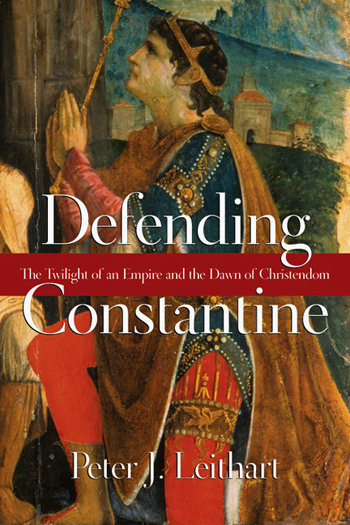Book reviews
 |
 |
 |
 |
 |
 |
 |
Modern Revolutionary Historians
on Constantine Discredited
Book review of
Defending Constantine, by Peter Leithart, Downers Grover, IL: InterVarsity Press, 2010, 372 pp.
To many historians Constantine, the first Roman Emperor to convert to the Catholic Church, is vilified as the man who wedded state power to religious authority. The famed historian John H. Yoder coined the term “Constantinian shift,” according to which the newly Catholic Emperor, depicted as a hypocrite and powerful politician, integrated his government with the Church in order to bring the energy of Christianity under his sway.
Yoder pretends that from the pacific communal purity of Christianity in the Catacombs, a faith persecuted and diametrically opposed to the world, Constantine brought the Catholic Bishops to heel, and made the Religion of the True God into a puppet branch of the secular power. From the 4th century until the Protestant Revolution, Yoder affirms, Christianity became political, a branch of the medieval order that served only to vindicate the rule of kings and emperors.
This is the image accepted and perpetuated by historians following the thesis of Yoder. But is it historical truth? In Defending Constantine Peter J. Leithart refutes this position, bringing to light the blatant historical falsehoods and bias that fueled Yoder's position. With an academic tone and insightful clarity, Leithart goes to the sources and demonstrates that not only was there no real “Constantinian shift,” but that the Catholic Order fostered by Constantine was the fulfillment and victory of Christianity, not its downfall.
Leithart sets the stage for the victory of Christianity by reviewing the disorder that the Roman Empire experienced during the 4th century. It is an account that gives too much credit to the policies of Constantine’s pagan predecessors, particularly the persecutor Diocletian, but it suffices to demonstrate the considerable chaos that the civilized world faced in the 3rd and 4th centuries. The world was in need of a Constantine.
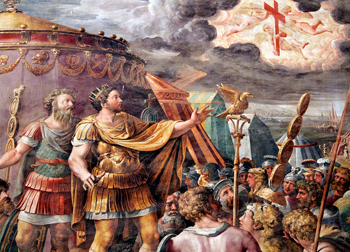 The heavenly image of the Cross that inspired Constantine to change his life and favor the Church at the Battle of the Milvian Bridge has been dismissed by many historians. Leithart defends it, although skeptically imagining it as a “sun halo,” a purely natural phenomenon. Nonetheless, he defends that this was the pivotal moment for Constantine that led him to abandon the pagan gods of Rome and adopt the Catholic God.
The heavenly image of the Cross that inspired Constantine to change his life and favor the Church at the Battle of the Milvian Bridge has been dismissed by many historians. Leithart defends it, although skeptically imagining it as a “sun halo,” a purely natural phenomenon. Nonetheless, he defends that this was the pivotal moment for Constantine that led him to abandon the pagan gods of Rome and adopt the Catholic God.
Historians like Yoder have largely relied on Protestant or Enlightenment sources to denigrate Constantine’s conversion, but Leithart draws on Constantine’s own words and actions to demonstrate that it was a genuine religious experience, not a pragmatic decision. After all, Constantine was turning his back on the religion of his primarily pagan army and Empire. Even after converting, he did not force Catholicism on his subjects, but rather encouraged it by his imperial favor.
From here, Leithart’s work refutes the bias and mistakes of Yoder’s bad history. Yoder was approaching Constantine largely to prove the historical narrative of the Anabaptists: that there was an early Christian purity from which the Catholic Church fell when she left the Catacombs. This “fall of the true Church” was supposedly a betrayal of Christian opposition to politics, power and any form of violence.
The author undermines Yoder’s position by pointing out that the onus of proof is on Yoder to demonstrate such a fall and that this he cannot do. On the contrary, Leithart shows that while there were some deeply pacific early Christian martyrs, there were also many who were soldiers.
Whereby Yoder asserts that soldier-martyrs were pacifists who were killed for refusing to fight, Leithart points out they were executed only when they refused to participate in the pagan rituals, a mandatory pre-battle practice of the pagan Roman military. This coincides with other early Christian writers who debated the validity of just war rather than issue an outright condemnation of it. Early monks and even Bishops were known to use or incite legitimate violence against perceived heretics and pagan temples.
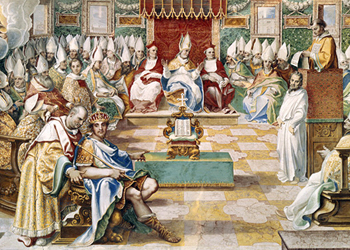 The politics of power is another “disease” that supposedly afflicted the post-Catacomb Church according to the anti-Constantinian narrative. According to Yoder's “shift,” the early Christians changed their position of opposing the Empire and all its pomp and politics. To counter this, Leithart uses numerous New Testament and early Christian examples showing that Christians had a sense of duty and loyalty to the Empire. Christians believed, then as now, that earthly authority was granted by God and that, barring instances of pagan sacrifice, Catholics were obliged to be obedient to the State.
The politics of power is another “disease” that supposedly afflicted the post-Catacomb Church according to the anti-Constantinian narrative. According to Yoder's “shift,” the early Christians changed their position of opposing the Empire and all its pomp and politics. To counter this, Leithart uses numerous New Testament and early Christian examples showing that Christians had a sense of duty and loyalty to the Empire. Christians believed, then as now, that earthly authority was granted by God and that, barring instances of pagan sacrifice, Catholics were obliged to be obedient to the State.
Many revolutionary historians adhere to the image of Bishops being awed into subservience to Constantine. According to this wrong model, the exchanges between Constantine and Bishops represented a merging of the Church with the Roman world. Thus, the Church became the instrument for reinforcing imperial power all the way to the Protestant Revolution. Yoder even claims that the Church was so Rome-centric that the only missionary work done for a millennium after Constantine was carried out by those deemed “heretics” through the political machine of the Pope. But all of this falls short under Leithart’s cutting analysis.
At Nicaea, Constantine did not attend the Council until invited and, even then, he would have taken the lowest seat. The Emperor had a practice of respecting the autonomy of the Catholic Church. As Emperor he had influence in the Church, but he did not impose. He did not appoint Bishops nor dictate doctrine. He typically did not interfere in Church affairs at all unless solicited or if numerous councils proved ineffective to address a problem.
It is true that he desired Church unity and that in itself this favored imperial interests, but Constantine’s letters can certainly be interpreted as the sentiments of a true believer. Most often Constantine pleaded with stubborn Bishops to retain Christian unity so as to protect the Church from ridicule. St. Athanasius even rebuked Constantine to his face, he notes, a far cry from the sycophant Bishops portrayed in “popular” history.
Constantine was not perfect and Leithart has no qualms about admitting the defects of a man who shone as ruler of the Western world. He was a proud man surely, one who made mistakes, but the depiction of Constantine bringing the Church to heel in the service of imperial ambition is demonstrated here to be untrue. In this way, Defending Constantine constitutes a strong dissent from the revolutionary position taken up by many historians.
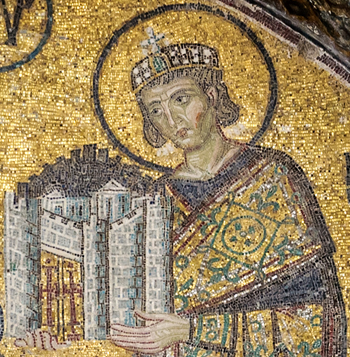 Yoder and others are too ready to perpetuate a narrative that casts the emergence of the Catholic Church, if not the Church herself, as a contamination of a supposed early Christian purity. Obviously, such a narrative serves the Protestant and secular anti-Catholic perspective. To be sure, there were instances in History when Bishops or Popes conceded to earthly powers, but these were exceptions and not the rule. The medieval world that followed Rome was a glorious vindication of Papal authority over earthly powers.
Yoder and others are too ready to perpetuate a narrative that casts the emergence of the Catholic Church, if not the Church herself, as a contamination of a supposed early Christian purity. Obviously, such a narrative serves the Protestant and secular anti-Catholic perspective. To be sure, there were instances in History when Bishops or Popes conceded to earthly powers, but these were exceptions and not the rule. The medieval world that followed Rome was a glorious vindication of Papal authority over earthly powers.
Leithart’s message is clear: What modern history teaches about Constantinianism is misinformed. The supposed deplorable subjugation of Religion to the power of the State under his rule did not in fact take place.
Leithart ends his book with an exhortation to the modern world: Modern civilization is more intrusive in matters of religion than Constantine ever was. Only when the Church limits herself to private devotions, non-secular piety or liturgies will the Modern State tolerate her. Any real attempt to exalt the Church above the secular order is abhorred. Dictatorships persecute the Church while democracies marginalize her. All too often Catholics themselves advocate for separation of Church and State, while cathedrals literally cower in the shadow of skyscrapers.
If modern civilization were to truly adopt Christianity, the politics of Christ could remake the modern world in much the way it changed the ancient one. But this can only happen if the world humbly submits to the authority of Christ’s Church and her teachings. Leithart believes that modern civilization can be saved, but only if it, like Constantine, comes forward humbly asking for its baptism.

Yoder pretends that from the pacific communal purity of Christianity in the Catacombs, a faith persecuted and diametrically opposed to the world, Constantine brought the Catholic Bishops to heel, and made the Religion of the True God into a puppet branch of the secular power. From the 4th century until the Protestant Revolution, Yoder affirms, Christianity became political, a branch of the medieval order that served only to vindicate the rule of kings and emperors.
This is the image accepted and perpetuated by historians following the thesis of Yoder. But is it historical truth? In Defending Constantine Peter J. Leithart refutes this position, bringing to light the blatant historical falsehoods and bias that fueled Yoder's position. With an academic tone and insightful clarity, Leithart goes to the sources and demonstrates that not only was there no real “Constantinian shift,” but that the Catholic Order fostered by Constantine was the fulfillment and victory of Christianity, not its downfall.
Leithart sets the stage for the victory of Christianity by reviewing the disorder that the Roman Empire experienced during the 4th century. It is an account that gives too much credit to the policies of Constantine’s pagan predecessors, particularly the persecutor Diocletian, but it suffices to demonstrate the considerable chaos that the civilized world faced in the 3rd and 4th centuries. The world was in need of a Constantine.

A sincere conversion at the Milvian Bridge
Historians like Yoder have largely relied on Protestant or Enlightenment sources to denigrate Constantine’s conversion, but Leithart draws on Constantine’s own words and actions to demonstrate that it was a genuine religious experience, not a pragmatic decision. After all, Constantine was turning his back on the religion of his primarily pagan army and Empire. Even after converting, he did not force Catholicism on his subjects, but rather encouraged it by his imperial favor.
From here, Leithart’s work refutes the bias and mistakes of Yoder’s bad history. Yoder was approaching Constantine largely to prove the historical narrative of the Anabaptists: that there was an early Christian purity from which the Catholic Church fell when she left the Catacombs. This “fall of the true Church” was supposedly a betrayal of Christian opposition to politics, power and any form of violence.
The author undermines Yoder’s position by pointing out that the onus of proof is on Yoder to demonstrate such a fall and that this he cannot do. On the contrary, Leithart shows that while there were some deeply pacific early Christian martyrs, there were also many who were soldiers.
Whereby Yoder asserts that soldier-martyrs were pacifists who were killed for refusing to fight, Leithart points out they were executed only when they refused to participate in the pagan rituals, a mandatory pre-battle practice of the pagan Roman military. This coincides with other early Christian writers who debated the validity of just war rather than issue an outright condemnation of it. Early monks and even Bishops were known to use or incite legitimate violence against perceived heretics and pagan temples.

Constantine taking a lower place at Nicaea
Many revolutionary historians adhere to the image of Bishops being awed into subservience to Constantine. According to this wrong model, the exchanges between Constantine and Bishops represented a merging of the Church with the Roman world. Thus, the Church became the instrument for reinforcing imperial power all the way to the Protestant Revolution. Yoder even claims that the Church was so Rome-centric that the only missionary work done for a millennium after Constantine was carried out by those deemed “heretics” through the political machine of the Pope. But all of this falls short under Leithart’s cutting analysis.
At Nicaea, Constantine did not attend the Council until invited and, even then, he would have taken the lowest seat. The Emperor had a practice of respecting the autonomy of the Catholic Church. As Emperor he had influence in the Church, but he did not impose. He did not appoint Bishops nor dictate doctrine. He typically did not interfere in Church affairs at all unless solicited or if numerous councils proved ineffective to address a problem.
It is true that he desired Church unity and that in itself this favored imperial interests, but Constantine’s letters can certainly be interpreted as the sentiments of a true believer. Most often Constantine pleaded with stubborn Bishops to retain Christian unity so as to protect the Church from ridicule. St. Athanasius even rebuked Constantine to his face, he notes, a far cry from the sycophant Bishops portrayed in “popular” history.
Constantine was not perfect and Leithart has no qualms about admitting the defects of a man who shone as ruler of the Western world. He was a proud man surely, one who made mistakes, but the depiction of Constantine bringing the Church to heel in the service of imperial ambition is demonstrated here to be untrue. In this way, Defending Constantine constitutes a strong dissent from the revolutionary position taken up by many historians.

Constantine protecting – not manipulating – the Church
Leithart’s message is clear: What modern history teaches about Constantinianism is misinformed. The supposed deplorable subjugation of Religion to the power of the State under his rule did not in fact take place.
Leithart ends his book with an exhortation to the modern world: Modern civilization is more intrusive in matters of religion than Constantine ever was. Only when the Church limits herself to private devotions, non-secular piety or liturgies will the Modern State tolerate her. Any real attempt to exalt the Church above the secular order is abhorred. Dictatorships persecute the Church while democracies marginalize her. All too often Catholics themselves advocate for separation of Church and State, while cathedrals literally cower in the shadow of skyscrapers.
If modern civilization were to truly adopt Christianity, the politics of Christ could remake the modern world in much the way it changed the ancient one. But this can only happen if the world humbly submits to the authority of Christ’s Church and her teachings. Leithart believes that modern civilization can be saved, but only if it, like Constantine, comes forward humbly asking for its baptism.

Posted November 25, 2016
______________________
______________________
 Volume I |
 Volume II |
 Volume III |
 Volume IV |
 Volume V |
 Volume VI |
 Volume VII |
 Volume VIII |
 Volume IX |
 Volume XI |
 Special Edition |
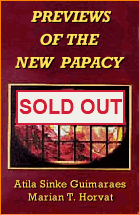 Special Edition |
